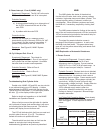
Supply water pressure is too low (less than 30
psig).
7. Electronics
Symptom(s) Diagnosed:
When on/off/drain switch
is switched on, green status lamp does not come
on.
Probable Cause(s):
Green status lamp is
damaged. (Long life LED should never burn out.)
NHB electronic board assembly was damaged in
shipment or installation. Electronics need to be
replaced.
8. Yellow and Green Status Lamps Both On
Symptom(s) Diagnosed:
Water has reached the
top of the cylinder and activated the high water
sensor circuit. Note: This is normal on startup
and at end of cylinder life.
Probable Cause(s):
Normal on startup with a new
cylinder. Can last for several hours until cylinder
reaches optimum contained water conductivity or
electrodes can no longer provide rated capacity
(or adjusted capacity). Water level automatically
rises to seek out fresh electrode surface to meet
the demand.
Unit Takes Self-Corrective Action:
Yes. It stops
the fill valve to prevent overfilling.
USING THE WIRING DIAGRAM
Fixed to the inside of each unit’s door is a wiring
diagram showing all of the internal (and most of the
external) wiring details. Additional external wiring
details can also be found with any electrical
accessories purchased from NORTEC.
The following is a detailed explanation of how the
NH humidifier (with and without options) operates.
Direct reference is made to the wiring diagram.
Reviewing the proper function in detail will make it
easier to troubleshoot if something goes wrong.
The wiring diagram details a 24 Vac control circuit
and a primary voltage circuit.
NHMC/NHP
A primary-to-24 Vac 75 VA transformer, tapped
from the primary, powers the 24 Vac control circuit.
One leg of the secondary is connected to ground and
terminals 6 and 46 on the electronics. The “hot leg”
finds its way to the electronics via the following in
series: the external on/off controls (if present),
terminals 8-10, the blower pack mounted on/off
humidistat (if present), terminals 84-85 and finally the
cabinet mounted on/off humidistat (if present). 24 Vac
arrives at the electronics’ terminals 10 (hot) and 6
(ground). A second “hot leg” takes a more direct route
to terminals 8, 18, 34, 38, 44 on the electronics via the
“on switch” and the door interlock switch in series.
The primary voltage circuit is what turns the water
in the cylinder to steam for humidification. The internal
primary fuses (if present) are followed by the primary
contactor(s). When the 24 Vac coil is powered, the
contactor “makes”. One primary leg is routed through
the core of the linear Hall Effect current sensing circuit
on the electronics, then it goes to the cylinder. The
high water sensor board has a primary voltage side.
One leg connects to the primary leg; one leg connects
to the short sensor pin in the top of the cylinder. A
potential, somewhat less than primary, is picked up by
the sensor at high water level, which “makes” the
red/black circuit on the low voltage side. This creates
a resistive loop across terminals 42-48 on the
electronics which stops the fill valve until water boils
down below the sensor pin.
Back at the electronics, the contactor receives its
“hot leg” from terminal 12. The fill receives its “hot leg”
from terminal 14. The drain receives its “hot leg” from
terminal 16. Unlike the contactor and fill, the drain
gets its “ground leg” directly from the transformer. It
does not depend on the air proving switch to activate.
The yellow and green unit status lamps are LED’s.
Polarity is important. Terminal 4 is positive dc supply.
Terminals 22 and 24 are switched dc grounds for
yellow and green respectively.
NHB
A primary-to-24 Vac 75 VA transformer, tapped
from the primary, powers the 24 Vac control circuit.
One leg of the secondary is connected to ground and
terminal 6 on the electronics. The “hot leg” finds its
way to the electronics via the following in series: the
external on/off controls (if present), terminals 8-10, the
blower pack mounted on/off humidistat (if present),
terminals 84-85 and finally the cabinet mounted on/off
humidistat (if present). 24 Vac arrives at the
electronics’ terminals 10 (hot) and 6 (ground). An
onboard 3.15 amp glass fuse protects the circuit. A
second “hot leg” takes a more direct route to terminals
8 and 18 on the electronics via the “on switch” and the
door interlock switch in series.
The primary voltage circuit is what turns the water
in the cylinder to steam for humidification. The internal
primary fuses (if present) are followed by the primary
contactor(s). When the 24 Vac coil is powered, the
contactor “makes”. One primary leg is routed through
the core of the linear Hall Effect current sensing circuit
on the electronics, then it goes to the cylinder. The
-21-


















